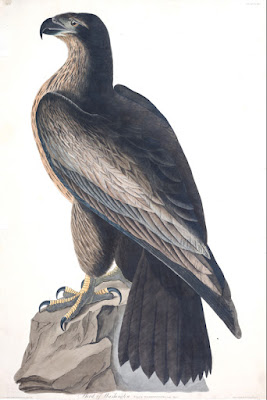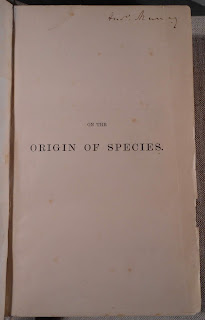 In celebration of our new single-case exhibit on display in Rauner- Some Truly Odd Birds: Audubon’s Mysterious
Aviary - we’d like to present one intriguing bird that we (literally)
didn’t have space to display. As we mentioned in a previous post, among the 435 bird species drawn and
painted by artist and ornithologist John James Audubon (1785-1851) for his
monumental work, The Birds of America (printed
between 1827-1838), a handful continue to puzzle ornithologists. Chief
among these is an elusive gigantic eagle he named "The Bird of Washington" (Falco washingtonii) which he excitedly
first documented in 1814 as it flew along the banks of the Mississippi River
near the Great Lakes:
In celebration of our new single-case exhibit on display in Rauner- Some Truly Odd Birds: Audubon’s Mysterious
Aviary - we’d like to present one intriguing bird that we (literally)
didn’t have space to display. As we mentioned in a previous post, among the 435 bird species drawn and
painted by artist and ornithologist John James Audubon (1785-1851) for his
monumental work, The Birds of America (printed
between 1827-1838), a handful continue to puzzle ornithologists. Chief
among these is an elusive gigantic eagle he named "The Bird of Washington" (Falco washingtonii) which he excitedly
first documented in 1814 as it flew along the banks of the Mississippi River
near the Great Lakes: "It was in the month of February 1814 that I obtained the first sight of this noble bird, and never shall I forget the delight which it gave me. Not even Herschel, when he discovered the planet which bears his name, could have experienced more rapturous feelings (Audubon 999: 217)."
Audubon subsequently recorded four more observations of what he called "indisputably the noblest bird of its genus that has yet been discovered." Eventually he shot a male bird as it fed on the carcass of a dead horse, which served as the model for his regal painting. The "Bird of Washington" stood nearly four feet tall and glided on a towering 10-foot wingspan, making it larger than any other eagle species in the world. Due to its impressive stature, Audubon decided to name the new species after one of America’s most beloved military and political figures - George Washington:
"in the United States, I trust I shall be allowed to honour it with the name of one yet nobler; who was the saviour of his country. and whose name will ever be dear to it. To those who may be curious to know my reasons, can only say, that, as the new world gave me birth and liberty, the great man who ensured its independence is next to my heart. He had a nobility of mind, and a generosity of soul, such as are seldom possessed."
Audubon goes further in his explanation for the suitability of the new species’ name, drawing comparisons between our nation’s first president and the bird: " He was brave, so is the Eagle; like it, too, he was the terror of his foes; and his fame, extending from pole to pole, resembles the majestic soarings of the mightiest of the feathered tribe. If America has reason to be proud of her Washington, so has she to be proud of her great eagle. (Audubon 1999:220)"
Audubon even made sure his painting conveyed General Washington’s commanding presence as depicted in military paintings; the immense raptor was painted in profile, gazing off into the distance with an out-puffed chest.
Despite Audubon’s infatuation with what he presumed to be a new species, following his death in 1851, incredulity about the Washington eagle mounted to the point that a generation later it was said only "amateur ornithologists" still considered it to be a real species (Allen 1870). When asked to comment on the Washington eagle, the eminent Elliot Coues said, "I wonder how many times the 'Washington eagle' must be put down before it will stay down! As a species, it is a myth…" What's the consensus today? Now it’s universally presumed that the few Washington Eagles Audubon and others saw were not members of a previously unidentified eagle species but were rather a common bird long known to naturalists: the common bald eagle in its immature state of development.
Interested in learning more about the scientific mysteries gracing the pages of Audubon’s famous book? Be sure to stop by Rauner Library between now and April to explore our exhibit (Some Truly Odd Birds: Audubon’s Mysterious Aviary) on display in our lobby, and as always, come into our Reading Room to see our first edition of The Birds of America.


